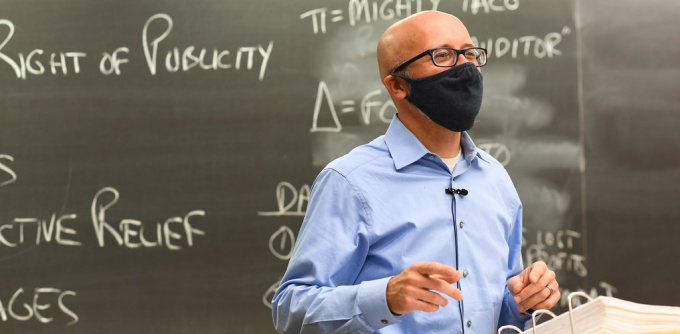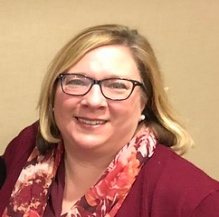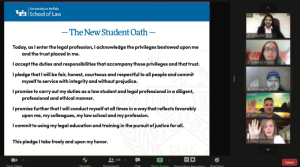
Being careful in the classroom: Professor Mark Bartholomew teaches a socially distant, reduced capacity class.
Responding to COVID-19
As the world scrambled in 2020 to regain its footing after the disruption of a pandemic, UB School of Law drew on reserves of talent and creativity– and its mission of legal education didn’t skip a beat.
Students, faculty and staff all found ways to continue their work while keeping themselves and each other healthy. That included the enormous task of transitioning all spring-semester classes to a virtual platform, and carefully implementing a hybrid plan – with some in-person classes, some online, and some a combination of both – in the fall.
For an institution as large and complex as the law school, that was no small achievement. It meant working with faculty and adjunct instructors to revise their syllabi and equip them with the tools for teaching online; figuring out how clinics could best serve their clients remotely; conducting mock trial and moot court competitions online; and incorporating the social and legal impact of the COVID crisis into the content of the courses themselves.
“Our faculty really dove into this,” says Professor S. Todd Brown, vice dean for academic affairs. “Even some who don’t normally lean on technology really threw themselves into understanding what the technology can do, and how they could use it to offset the fact they wouldn’t be able to meet in class.” In large part, he says, that’s a credit to the law school’s information technology department, which designed and conducted a blitz of training early in the spring. For instructors – full-time faculty and adjuncts alike – who were used to standing an arm’s reach from their students, that meant getting up to speed with Zoom and the course management software UB Learns. Then they had to communicate clearly to students on the new expectations for courses already in progress.

Professor S. Todd Brown
Members of the Class of 2023 take the New Student Oath during the law school’s Fall 2020 Virtual Orientation.
“It really began with our IT team,” Brown says, “not just the training, but having immediate access to them if you had questions. I think there were six different ways to contact them, and they always had someone there.”
Planning for the fall semester, he says, was complicated by the many unknowns about the virus and its risks. Over the summer, academics who typically spend those months on their scholarship, participated in numerous planning sessions by Zoom. The fall course schedule was entirely reworked, another major undertaking.
The situation has offered some benefits, Brown says, in that adjuncts who are far from Buffalo can teach specialized courses that would otherwise be unavailable. Nevertheless, he says, the faculty are “really eager to get back in the physical classroom. You can’t replace the rapid fire that happens in a classroom. Zoom isn’t really designed to accommodate that.”
The school also took pains to provide online services for its students and potential students. For example, newly admitted applicants – who typically are invited to campus to cement their bond with UB Law – got the whirlwind tour online. The Career Services Office similarly moved to a virtual platform, and student externships were reimagined to work remotely.

Vice Dean for Student Affairs Bernadette Gargano
And a full range of services and outreach lent a supportive hand to current students who were dealing with disruption in their lives as well as in their legal education. For one, they were reminded that the school’s Emergency Student Assistance Fund stands ready to fill gaps in their budget due to unexpected issues such as loss of income or a family health emergency.
“It’s been a difficult time,” acknowledges Bernadette Gargano, vice dean for student affairs. “Our students have faced unprecedented challenges since the start of the pandemic – many of the same challenges we’re all facing, in addition to the rigors of law school.” It’s been particularly hard, she says, on the first-years, who’ve had to get their academic bearings with less opportunity to build supportive in-person relationships with classmates. To help, the law school created a COVID-19 online toolbox to supplement the University’s dashboard, providing a one-stop shop to connect with tech support, emergency aid and counseling.
Student organizations and the Student Bar Association have also worked to build community online with social gatherings and programming. And the attention of their professors, help from teaching assistants, the friendly ear of alumni mentors, and a new program of peer-to-peer advocates have helped students to know that coping is a group effort.
“Even as we continue to face challenges,” Gargano says, “our students are keeping on with their studies and showing their dedication to their future profession. They’ve risen to the opportunity to make their law school community even stronger, by supporting each other and being innovative.”
